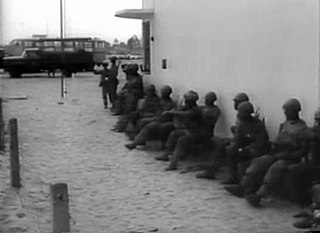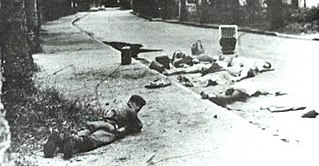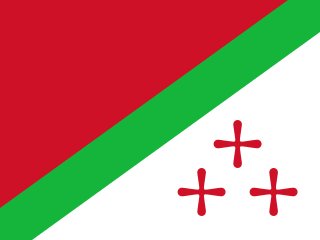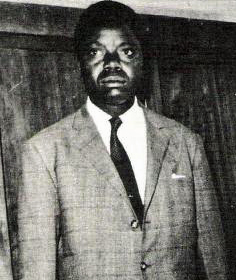 W
WThe Congo Crisis was a period of political upheaval and conflict in the Republic of the Congo between 1960 and 1965. The crisis began almost immediately after the Congo became independent from Belgium and ended, unofficially, with the entire country under the rule of Joseph-Désiré Mobutu. Constituting a series of civil wars, the Congo Crisis was also a proxy conflict in the Cold War, in which the Soviet Union and the United States supported opposing factions. Around 100,000 people are believed to have been killed during the crisis.
 W
WThe Léopoldville riots were an outbreak of civil disorder in Léopoldville in the Belgian Congo which took place in early 1959 and which were an important moment for the Congolese independence movement. The rioting occurred when members of the Alliance des Bakongo (ABAKO) political party were not allowed to assemble for a protest and colonial authorities reacted harshly. The exact death toll is not known, but at least 49 people were killed and total casualties may have been as high as 500. The Congo received its independence on 30 June 1960, becoming the Republic of the Congo.
 W
WOn 5 July 1960, soldiers of the garrisons of Léopoldville and Thysville of the Force Publique, the army of the newly independent Democratic Republic of the Congo mutinied against their white officers. The revolt quickly spread throughout the Lower Congo and engulfed the country in disorder, beginning the Congo Crisis.
 W
WThe Battle of Kabalo was a battle fought at Kabalo by United Nations peacekeeping forces and Baluba militias from 7 April to 11 April 1961 against mercenaries and the gendarmerie of the State of Katanga, a secessionist state rebelling against the Republic of the Congo in central Africa. The Katangese forces attacked the town as part of a larger offensive meant to restore their authority in northern Katanga which was challenged by the Baluba. A United Nations Operation in the Congo peacekeeping contingent garrisoning Kabalo, acting under the authority of their mandate to prevent civil war in the country, resisted the initial attack and arrested 30 mercenaries in Katanga's employ. Armed Baluba repelled a Katangese ferry carrying troops as well as an armoured train. The next day the ferry returned but was sunk by UN forces. Fighting continued over the next few days between the Baluba and Katangese until the latter withdrew. The battle led to a deterioration of relations between the Katangese government and the United Nations Operation in the Congo.
 W
WThe Free Republic of the Congo, often referred to as Congo-Stanleyville, was a short-lived rival government to the Republic of the Congo (Congo-Léopoldville) based in the eastern Congo and led by Antoine Gizenga.
 W
WOperation Dragon Rouge was a hostage rescue operation in the Democratic Republic of the Congo conducted by Belgium and the United States in 1964. The operation was led by the Belgian Paracommando Regiment to rescue hostages held by Simba rebels in the town of Stanleyville.
 W
WThe siege of Jadotville was an engagement during the Congo Crisis in September 1961. "A" Company, 35th Battalion of the Irish Army ONUC contingent was attacked by Katangese Gendarmerie troops loyal to the Katangese Prime Minister Moïse Tshombe. The lightly armed Irish soldiers, besieged in Jadotville, resisted Katangese assaults for five days as a relief force of Irish, Indian and Swedish troops unsuccessfully attempted to reach the Irish force.
 W
WThe State of Katanga, also sometimes denoted as the Republic of Katanga, was a breakaway state that proclaimed its independence from Congo-Léopoldville on 11 July 1960 under Moise Tshombe, leader of the local Confédération des associations tribales du Katanga (CONAKAT) political party. The new Katangese state did not enjoy full support throughout the province and was constantly plagued by ethnic strife in its northernmost region. It was dissolved in 1963 following an invasion by United Nations Operation in the Congo (ONUC) forces, and reintegrated with the rest of the country as Katanga Province.
 W
WThe Katangese Gendarmerie, officially the Katangese Armed Forces, was the paramilitary force of the unrecognized State of Katanga in Central Africa from 1960 to 1963. The forces were formed upon the secession of Katanga from the Republic of the Congo with help from Belgian soldiers and former officers of the Force Publique. Belgian troops also provided much of the early training for the Gendarmerie, which was mainly composed of Katangese but largely led by Belgians and later European mercenaries.
 W
WThe Kindu massacre, or Kindu atrocity, took place on 11 or 12 November 1961 in Kindu Port-Émpain, in the Congo-Léopoldville, where thirteen Italian airmen, members of the United Nations Operation in the Congo (ONUC), sent to pacify the country ravaged by civil war, were murdered. The Italian aviators manned two C-119s, twin-engined transport aircraft known as Flying Boxcars, of the 46ª Aerobrigata based at Pisa Airfield.
 W
WThe Kwilu rebellion (1963–1965) was a civil uprising which took place in the West of what is the modern-day Democratic Republic of the Congo. The rebellion took place in the wider context of the Cold War and the Congo Crisis. Led by Pierre Mulele, a follower of ousted Prime Minister Patrice Lumumba, a faction of rebel Maoists staged a revolt against the government in the Kwilu District. Based around the struggle for independence, the rebellion was encouraged by economic, social, and cultural grievances. Supported by communist China, rebels used mainly guerrilla warfare against government forces. The rebellion was concurrent with the Simba Rebellion occurring in other areas of the Congo during this time. While the rebellion was suppressed in the early months of 1965, it had lasting political impacts, leading to the dissolution of Kwilu as an official province.
 W
WThe Ndola United Nations DC-6 crash occurred on 18 September 1961 in Northern Rhodesia. The crash resulted in the deaths of all people onboard including Dag Hammarskjöld, the second Secretary-General of the United Nations, and 15 others. Hammarskjöld had been en route to cease-fire negotiations with Moise Tshombe during the Congo Crisis. Three official inquiries failed to determine conclusively the cause of the crash, which set off a succession crisis at the United Nations.
 W
WThe Niemba ambush took place on 8 November 1960, when an Irish Army platoon in Congo-Léopoldville was ambushed, the first time the Irish Army was embroiled in battle since the founding of the Irish state in 1922. The Republic of Ireland had deployed troops as United Nations Operation in the Congo (ONUC) peacekeepers.
 W
WOperation Grandslam was an offensive undertaken by United Nations peacekeeping forces from 28 December 1962 to 15 January 1963 against the gendarmerie of the State of Katanga, a secessionist state rebelling against the Republic of the Congo in central Africa. The Katangese forces were decisively defeated and Katanga was forcibly reintegrated into the Congo.
 W
WOperation Rum Punch was a military action undertaken by United Nations peacekeeping forces on 28 August 1961 against the military of the State of Katanga, a secessionist state from the Republic of the Congo in central Africa. UN troops arrested 79 foreign mercenaries and officers employed by Katanga with little conflict.
 W
WThe Siege of Jadotville is a 2016 action-war film directed by Richie Smyth and written by Kevin Brodbin. An Irish-South African production, the film is based on Declan Power's book, The Siege at Jadotville: The Irish Army's Forgotten Battle (2005), about an Irish Army unit's role in the UN peacekeeping mission in the Congo in September 1961.
 W
WThe Simba rebellion of 1963–65, also known as the Orientale Revolt, was a rebellion in the Democratic Republic of the Congo which took place within the wider context of the Congo Crisis and the Cold War. The rebellion, located in the east of the country, was led by the followers of Patrice Lumumba, who had been ousted from power in 1960 by Joseph Kasa-Vubu and Joseph-Désiré Mobutu and subsequently killed in January 1961 in Katanga. The rebellion was contemporaneous with the Kwilu Rebellion led by fellow Lumumbist Pierre Mulele in central Congo.
 W
WSouth Kasai was an unrecognised secessionist state within the Republic of the Congo which was semi-independent between 1960 and 1962. Initially proposed as only a province, South Kasai sought full autonomy in similar circumstances to the much larger neighbouring state of Katanga, to its south, during the political turmoil arising from the independence of the Belgian Congo known as the Congo Crisis. Unlike Katanga, however, South Kasai did not explicitly declare full independence from the Republic of the Congo or reject Congolese sovereignty.
 W
WThe Tshombe Government was the set of ministers that governed the Democratic Republic of the Congo under the leadership of Prime Minister Moïse Tshombe from 1964 to 1965.